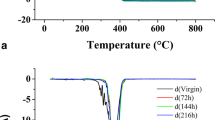Summary
Volume recovery of polycarbonate samples has been investigated by dilatometric and density measurements near ambient temperature. The volume changes with time have been measured either after heating above Tg and quenching, or after cold drawing at ambient temperature. Cold drawing drastically increases the volume recovery rate of polycarbonate, as compared with the rate observed after quenching. This is quite similar to the behavior previously reported on physical aging measured by dynamic mechanical tests (1). The observed decrease of specific volume after cold drawing can be explained by a densification effect due to molecular orientation.
Similar content being viewed by others
References
R.Pixa, C.Goett and D.Froelich, Polymer Bull.14, 53 (1985).
J.D.Ferry, “Viscoelastic Properties of Polymers,” (3rd ed.) John Wiley & Sons New York, 280 (1980).
A.J.Kovacs, Fortschr. Hochpolym. Forsch.3, 394 (1963).
G.Goldbach and G.Rehage, Rheol. Acta 6, 30 (1967).
L.C.E.Struik, “Physical Aging in Amorphous Polymers and Other Materials,” Elsevier Amsterdam (1978).
P. Bowden, in “The Physics of Glassy Polymers,” ed. by R.N. Haward, Applied Science Publishers London, 279 (1973).
R. N. Haward, in “The Physics of Glassy Polymers,” ed. by R.N.Haward, Applied Science Publishers London, 340 (1973).
A.J.Kovacs, J.J.Aklonis, J.M.Hutchinson and A.R.Ramos, J.Polymer Sci.: Polymer Phys.Ed. 17, 1097 (1979).
ASTM Standard D 1505-85.
R.Greiner and F.R.Schwarzl, Rheol.Acta 23, 378 (1984).
K.-H.Hellwege, J.Hennig and W.Knappe, Kolloid-Z.u.Z.f.Polymere 186, 29 (1962).
From fig.20 and 128 in ref.(5).
K.-H.Hellwege, J.Hennig and W.Knappe, Kolloid-Z.u.Z.f.Polymere 188, 121 (1963).
T.E.Brady and G.S.Y.Yeh, J.Appl.Phys. 42, 4622 (1971).
D.G.LeGrand, J.Appl.Polymer Sci. 16, 1367 (1972).
W.A.Spitzig and O.Richmond, Polymer Eng.Sci. 19, 1129 (1979).
R.E.Robertson, J.Phys.Chem. 69, 1575 (1965).
J.M.Powers and R.M.Caddell, Polymer Eng.Sci. 12, 432 (1972).
A.J.Kovacs, J.M.Hutchinson and J.J.Aklonis, in “The Structure of Non-Crystalline Materials,” ed. by P.H.Gaskell, Taylor and Francis London, 153 (1977).
J.P.Mercier and R.Legras, J.Polymer Sci. B8, 645 (1970).
S.Matsuoka, Polymer Eng.Sci. 21, 907 (1981).
Author information
Authors and Affiliations
Rights and permissions
About this article
Cite this article
Pixa, R., Grisoni, B., Gay, T. et al. Influence of deformation on physical aging of polycarbonate. Polymer Bulletin 16, 381–387 (1986). https://doi.org/10.1007/BF00255013
Accepted:
Issue Date:
DOI: https://doi.org/10.1007/BF00255013




